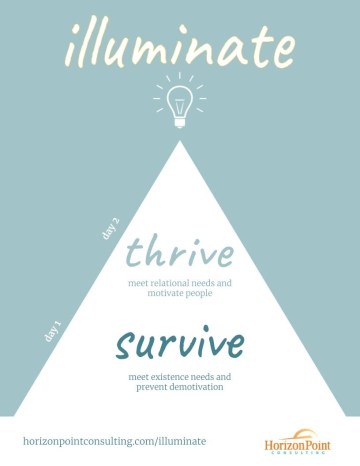With the great resignation still continuing and baby boomers, who many feel delayed retiring, now retired or retiring in large numbers due to the pandemic, succession planning has never been more important.
But as we’ve seen through many of our clients (and ourselves!), the need to get something done and getting it done are two different things. When it comes to succession planning, I think the key challenge is not knowing where to start and the steps to take once started. Overall, you need to:

1. Know your current talent state. This involves several sub-steps of determining:
a. What’s your talent funnel? This means mapping how people progress through the organizational hierarchy, determining the number of people needed at each level of hierarchy, realizing how turnover affects each level, and getting a good picture of the number of people needed to fill key vacancies.
b. What are your performance standards? This should be mapped out through your mission, vision, and values as an organization and connected to the KSAOS of each position.
c. And how do you measure them? A performance evaluation tool should be used, and in the case of succession planning especially, a way to measure performance potential should be deployed.
d. How is each person performing towards your company’s performance standards? Your measurement tools give you the way to determine how people are performing towards standards. In this step, it’s critical that leaders deploying the tools should be trained on how to use them effectively and given the bandwidth to execute this process effectively.
e. And what do they want out of your career? Understanding what individuals want and expect out of their career progression is imperative to this process. If you don’t know what people want, you may plan for progression that ends up being sabotaged because it doesn’t meet people’s needs or expectations. For more on this, read about our Leaders as Career Agents Process (Taylor is also speaking about this at the Birmingham SHRM meeting in May if you want to learn more!)
2. Know what you need to fill talent gaps both in terms of the number of people as well as the knowledge, skills, abilities, and other characteristics (KSAOS) needed for each position vacancy. This should consider not only what is needed to fill key vacancies in the current state, but also what will be needed to facilitate organizational growth. It also includes an accounting of what training and development are needed to equip people to fill the gaps.
3. Execute a talent management and development system and plan to meet the needs found in your gaps. Again, to execute effectively it is essential that leaders deploying the process are 1) trained to deploy it and 2) are given the bandwidth and support to deploy it well. In addition, it is critical that there be a calibration process done through collaboration to work across department lines to facilitate effective succession planning.
Want to learn more about this process through a real-life case study? Mary Ila is speaking at ALSHRM 2022 today (May 3, 2022) about this, but you can also catch her at Florida SHRM speaking on the topic in August 2022.
How do you successfully execute succession planning for your organization?





